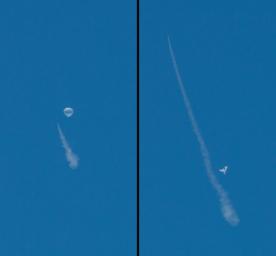
|
A Balloon’s Job Well Done: LDSD in Flight
- Click the image above for a larger view
- Full-Res JPEG (2324 x 2156) (355.6 kB)
- Full-Res TIFF (2324 x 2156) (15.0 MB)
Caption:
The test vehicle for NASA's Low-Density Supersonic Decelerator is seen here before and after the balloon that helped carry it to near-space was deflated. On June 28, 2014, a balloon lifted the 7,000-pound saucer-shaped vehicle to an altitude of 119,000 feet (36,270 meters), then a rocket boosted it even higher, where tests of Martian landing technologies began.
The test occurred off the coast of the U.S. Navy's Pacific Missile Range Facility in Kauai, Hawaii. NASA's Columbia Scientific Balloon Facility, based in Palestine, Texas, provided the balloon launch system and its operation.
The plume left by the test vehicle's main engine can be seen in these images. Engineers arranged for the balloon to deflate and descend shortly after the rocket fired.
Background Info:
NASA's Space Technology Mission Directorate funds the LDSD mission, a cooperative effort led by NASA's Jet Propulsion Laboratory in Pasadena, California. NASA's Technology Demonstration Mission program manages LDSD at NASA's Marshall Space Flight Center in Huntsville, Alabama. NASA's Wallops Flight Facility in Wallops Island, Virginia, coordinated support with the Pacific Missile Range Facility, provided the core electrical systems for the test vehicle, and coordinated the balloon and recovery services for the LDSD test.
For more information about the LDSD space technology demonstration mission: http://go.usa.gov/kzZQz .
Cataloging Keywords:
| Name | Value | Additional Values |
|---|---|---|
| Target | Earth | Mars |
| System | ||
| Target Type | Planet | |
| Mission | Low-Density Supersonic Decelerator Project (LDSD) | |
| Instrument Host | ||
| Host Type | ||
| Instrument | ||
| Detector | ||
| Extra Keywords | Color, Plume | |
| Acquisition Date | ||
| Release Date | 2014-08-08 | |
| Date in Caption | 2014-06-28 | |
| Image Credit | NASA/JPL-Caltech | |
| Source | photojournal.jpl.nasa.gov/catalog/PIA18466 | |
| Identifier | PIA18466 | |
